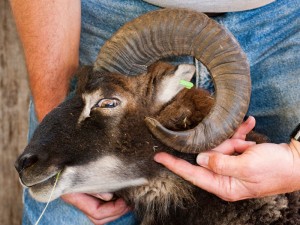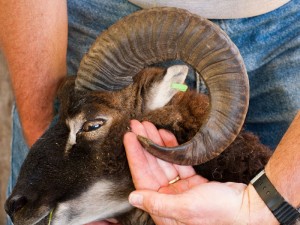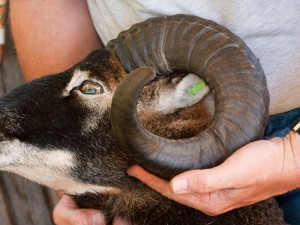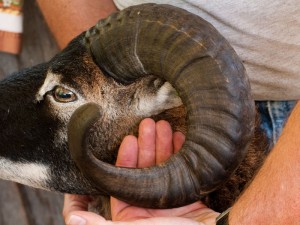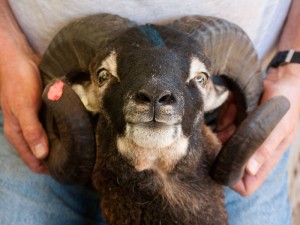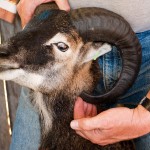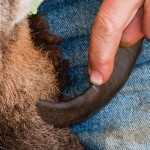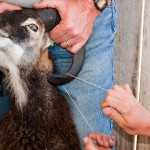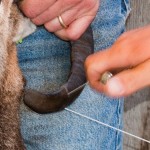Soay Sheep Horns, Part 2: When to trim or not trim
In my last post, I talked about how sheep horns grow and what shapes they can take, and I touched on the issue of when horns need to be cut for health reasons. Here I will walk you through a more detailed horn evaluation of two rams and then provide a pictorial demonstration of how to cut a horn.
HOW TO ANALYZE A SOAY RAM’S HORNS
Edward and McKee have been on our watch list since they were young lambs. Their horns are sufficiently tight that we need to be sure during and after each year’s horn growth that they still clear the jaw. These pictures were taken last summer (July 2011).
The diameter of Edward’s horn spiral is small and the anterior face of the spiral is slightly to the rear of the point of emergence from his head. Steve’s finger is on the corner of the jawbone.
Steve’s fingers are under the tip, confirming that it still clears. Because we did not need to cut the horn, we left it alone. When Steve checked it again seven months later while it was growing (February 2012), it still cleared, although not by much. Edward stays on the watch list.
First off, look at how much more horn growth McKee had at 2 years than Edward had at 3 years of age, something we had not focused on until now. Hmm.
In this picture, Steve’s finger is on the corner of McKee’s jaw. Although his spiral comes a little farther forward on his head than does Edward’s, McKee’s horn still is not touching his jaw.
Just to be sure, Steve fits the fat part of his fingers in the space between McKee’s horn and jawbone father back. So far so good.
This last picture shows McKee’s horns straight on. See the space between the horn and the furry corner of his jaw? As is usually the case, once the spiral has cleared at its lowest point, it either curls back up on the same plane as the main part of the spiral, or begins to form an outward corkscrew, as is the case here with McKee. But we’ll keep watching.
HOW TO CUT A SOAY RAM’s HORN
Occasionally we have no choice but to cut a horn growing into the neck or impinging on the jaw, and we close this pictorial analysis with a demonstration of how we do it. The ram is Darmsden, a 2010 ram whose horns had to be cut in July 2011 when he was a yearling.
1. Darmsden has very nicely shaped horns – medium diameter spiral, medium angle off his head – but the left horn aims right for his neck.
2. This picture shows how far back on his head the horn was turning in, with Steve’s finger on the corner of jaw. Most other rams’ horns start curving up much farther forward on the head.
3. Look at the lack of clearance. Steve cannot get his fingers between the tip and the neck. On Darmsden, it was not a question of impinging on the jaw; the horn came straight into his neck.
4. What about the other horn? Although Darmsden’s right horn had lots of clearance at the time we cut his left horn, we do not know where the right horn would have ended up because we decided to cut both horns for symmetry, an esthetic choice.
5. We don’t like to take off more than we need to, so Shawn put a pencil mark confirming where the cut would be made. We can always take more off later if the horn gets too close again.
6. Shawn places the saw wire at the pencil mark.
7. It only takes a few strokes (with fresh sharp wire) to get the horn off and it does not hurt the ram at all.
8. First cut is complete.
9. After both cuts, the horns are again symmetrical.
It is high time we hit the “publish” button on this post and turn our attention to lambing. By all means, give us a call or email us if you have questions about trimming ram horns. We will be pleased to walk you through it and, if we can, help you decide whether you need to trim a horn.
For now …
